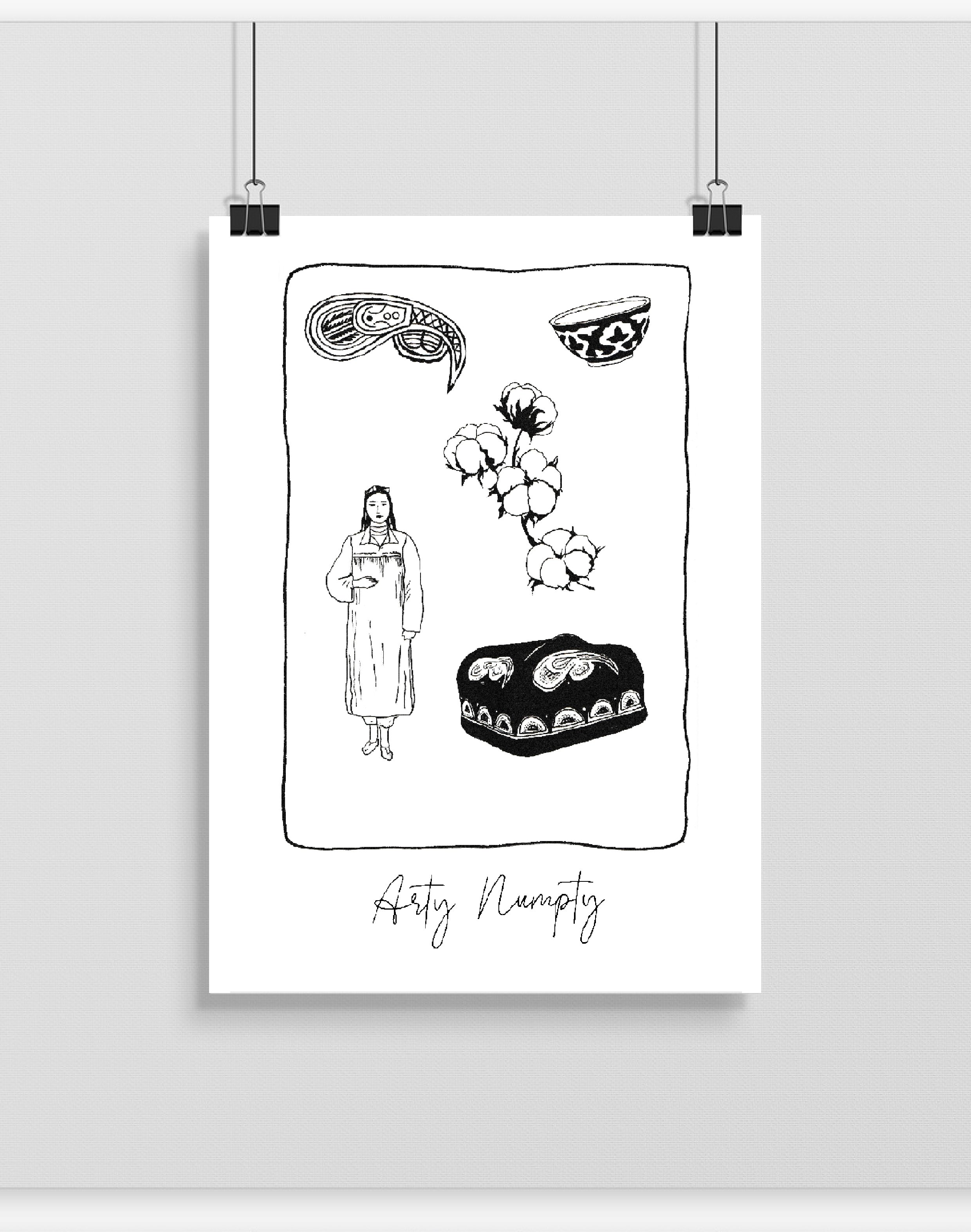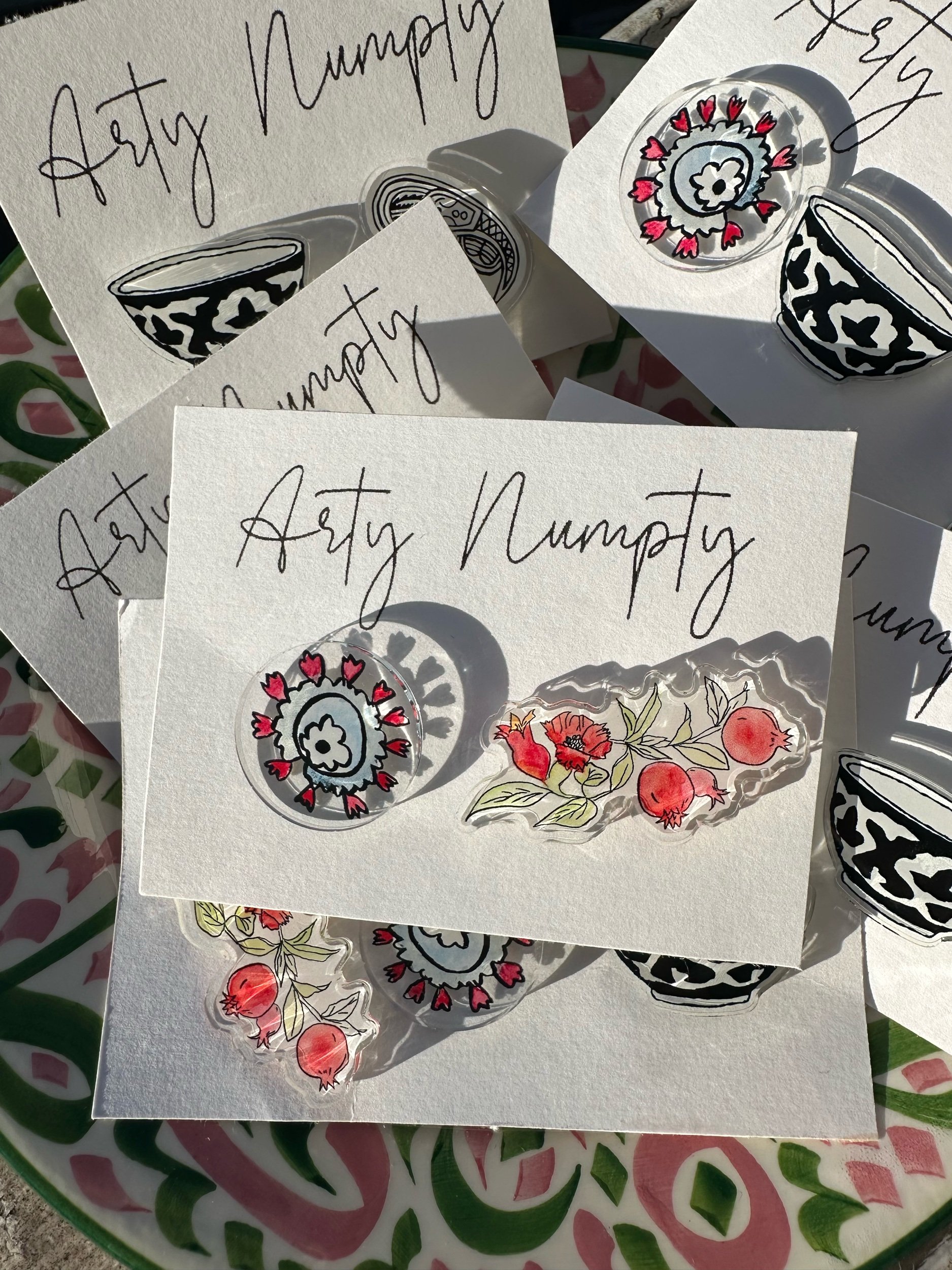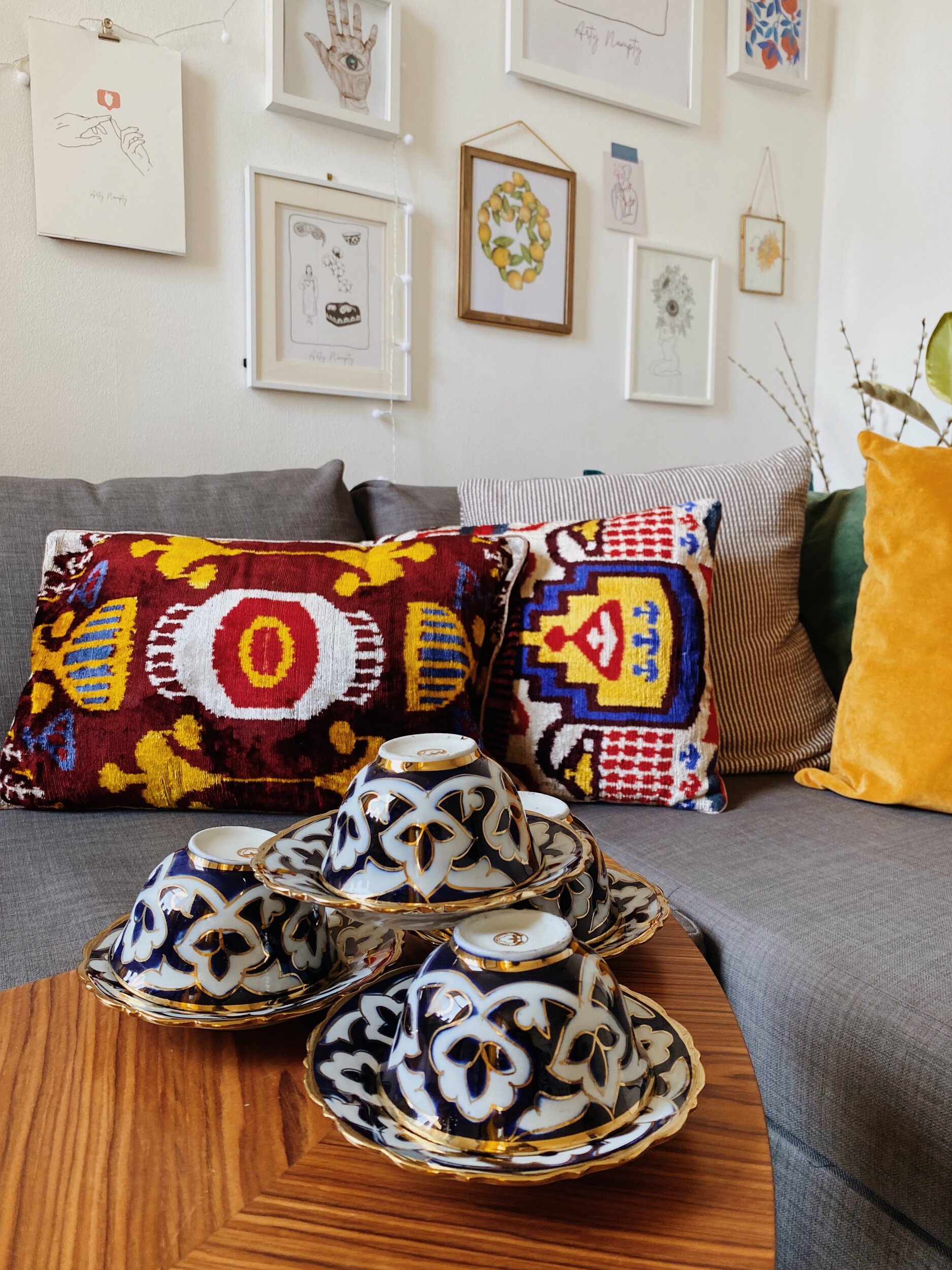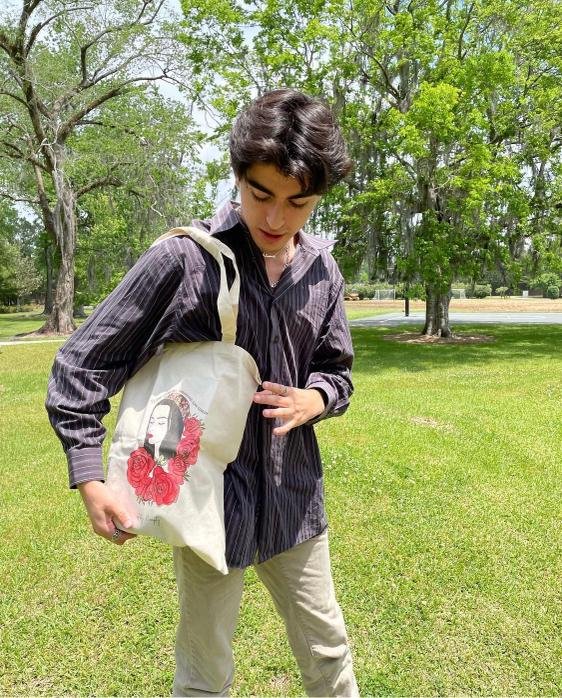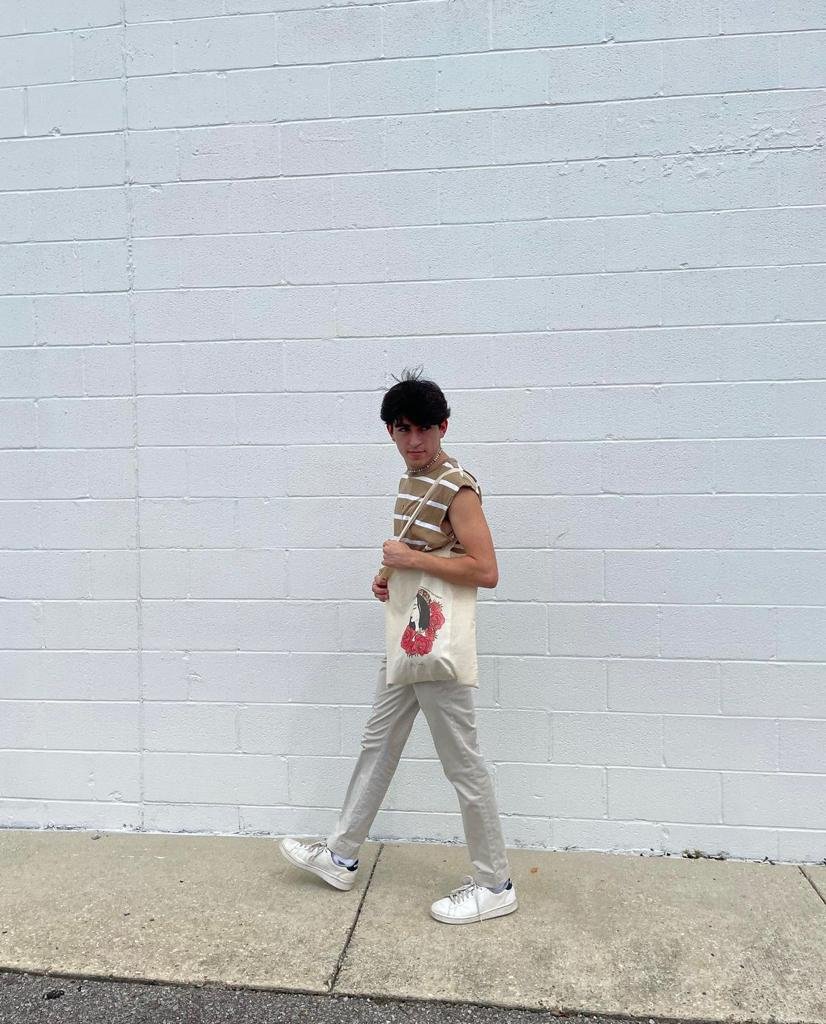Central Asia A2 Print Poster - Matte Finish (frame included)
A2 Matte Finish poster 420 x 594 mm (42 cm x 59.2cm)
Frame not included
Poster is sent via mailing tube
Central Asia
I focused on elements, ornaments and symbols that were always there throughout my childhood.
Kalampur 🌶
On the doppi, you can often typically see the ornament of capsicum 🫑 (pepper) - "kalampur" 🌶 Such an ornament is considered a symbol of life, family happiness and a talisman against the evil eye 🧿 The Uzbek doppi has four sides and each side is like a protection from evil spirits from each side of the world 🌍
Pahtagul 🌺
Pahtagul translating as the cotton flower is a very well known pattern throughout Central Asia and ex Soviet Union countries.
Cotton was the white gold of Uzbekistan. Pahtagul was sold throughout the USSR and has remained in many homes to this day.
Cotton flower is something I always related home to. Whilst my parents and most of the parents from ex Soviet Union countries remember it with a bitter sweet taste and having worked in the fields as students during USSR times, I think of it fondly. I always have cotton stems at home as a dry flower decor to have a piece of home 🇺🇿 at home 🏡
Kelin 👰♀️
Superkelinchak - one of the first films I remember watching with aunties, which both traumatised and enlightened me. Kelin translating from Uzbek as the young bride and superkelinchak translating as super young bride. I have 25 first cousins, and every time I’m back home I’m always attending someone’s wedding.
Do’ppi 🎩👒🧢
Do’ppi - square hat, which is barely touched but most often found in everyone’s home. Moderately uncomfortable, but with many meanings behind colours, symbols and ornaments. Each region has its own ornament. In ancient times you can even tell the status in the society, whether they’re single or married, and which region they’re from. It was like tinder, but through a simple effective do’ppi hat back in the day.
A2 Matte Finish poster 420 x 594 mm (42 cm x 59.2cm)
Frame not included
Poster is sent via mailing tube
Central Asia
I focused on elements, ornaments and symbols that were always there throughout my childhood.
Kalampur 🌶
On the doppi, you can often typically see the ornament of capsicum 🫑 (pepper) - "kalampur" 🌶 Such an ornament is considered a symbol of life, family happiness and a talisman against the evil eye 🧿 The Uzbek doppi has four sides and each side is like a protection from evil spirits from each side of the world 🌍
Pahtagul 🌺
Pahtagul translating as the cotton flower is a very well known pattern throughout Central Asia and ex Soviet Union countries.
Cotton was the white gold of Uzbekistan. Pahtagul was sold throughout the USSR and has remained in many homes to this day.
Cotton flower is something I always related home to. Whilst my parents and most of the parents from ex Soviet Union countries remember it with a bitter sweet taste and having worked in the fields as students during USSR times, I think of it fondly. I always have cotton stems at home as a dry flower decor to have a piece of home 🇺🇿 at home 🏡
Kelin 👰♀️
Superkelinchak - one of the first films I remember watching with aunties, which both traumatised and enlightened me. Kelin translating from Uzbek as the young bride and superkelinchak translating as super young bride. I have 25 first cousins, and every time I’m back home I’m always attending someone’s wedding.
Do’ppi 🎩👒🧢
Do’ppi - square hat, which is barely touched but most often found in everyone’s home. Moderately uncomfortable, but with many meanings behind colours, symbols and ornaments. Each region has its own ornament. In ancient times you can even tell the status in the society, whether they’re single or married, and which region they’re from. It was like tinder, but through a simple effective do’ppi hat back in the day.
A2 Matte Finish poster 420 x 594 mm (42 cm x 59.2cm)
Frame not included
Poster is sent via mailing tube
Central Asia
I focused on elements, ornaments and symbols that were always there throughout my childhood.
Kalampur 🌶
On the doppi, you can often typically see the ornament of capsicum 🫑 (pepper) - "kalampur" 🌶 Such an ornament is considered a symbol of life, family happiness and a talisman against the evil eye 🧿 The Uzbek doppi has four sides and each side is like a protection from evil spirits from each side of the world 🌍
Pahtagul 🌺
Pahtagul translating as the cotton flower is a very well known pattern throughout Central Asia and ex Soviet Union countries.
Cotton was the white gold of Uzbekistan. Pahtagul was sold throughout the USSR and has remained in many homes to this day.
Cotton flower is something I always related home to. Whilst my parents and most of the parents from ex Soviet Union countries remember it with a bitter sweet taste and having worked in the fields as students during USSR times, I think of it fondly. I always have cotton stems at home as a dry flower decor to have a piece of home 🇺🇿 at home 🏡
Kelin 👰♀️
Superkelinchak - one of the first films I remember watching with aunties, which both traumatised and enlightened me. Kelin translating from Uzbek as the young bride and superkelinchak translating as super young bride. I have 25 first cousins, and every time I’m back home I’m always attending someone’s wedding.
Do’ppi 🎩👒🧢
Do’ppi - square hat, which is barely touched but most often found in everyone’s home. Moderately uncomfortable, but with many meanings behind colours, symbols and ornaments. Each region has its own ornament. In ancient times you can even tell the status in the society, whether they’re single or married, and which region they’re from. It was like tinder, but through a simple effective do’ppi hat back in the day.


